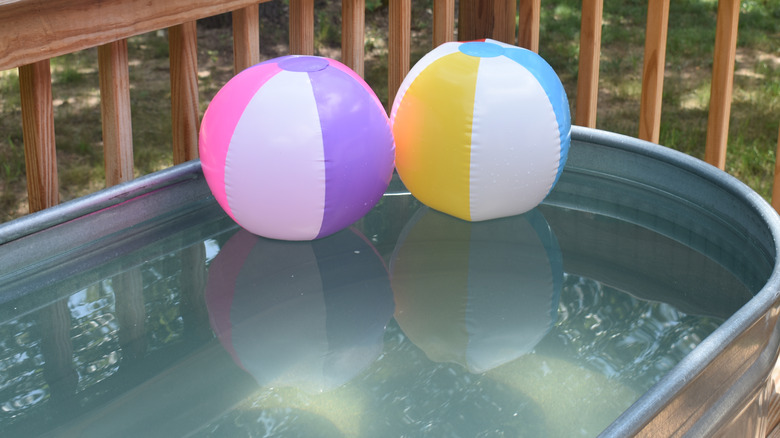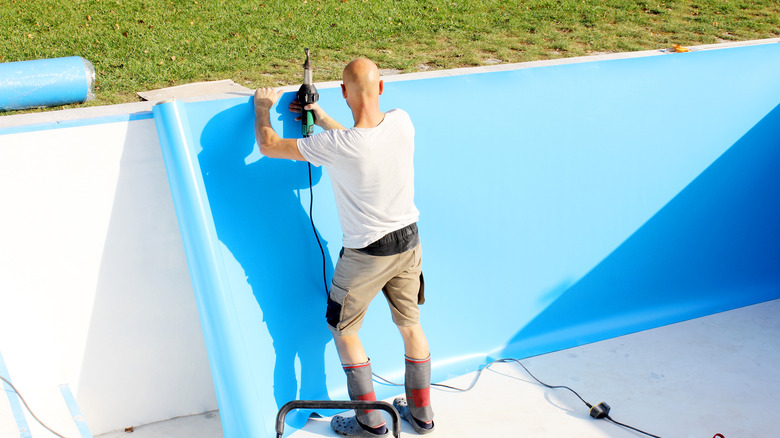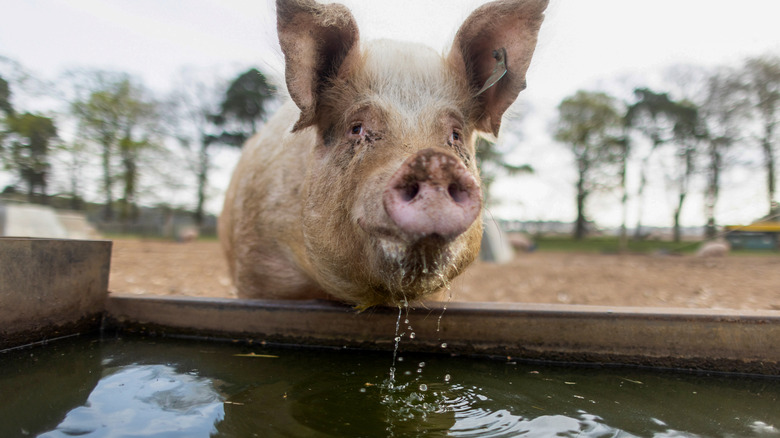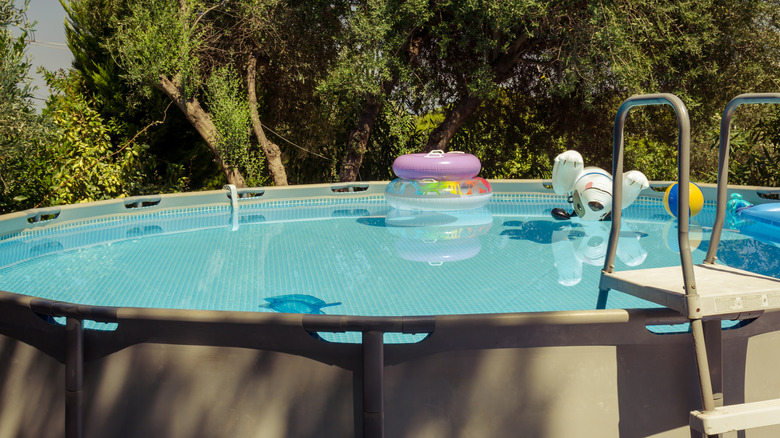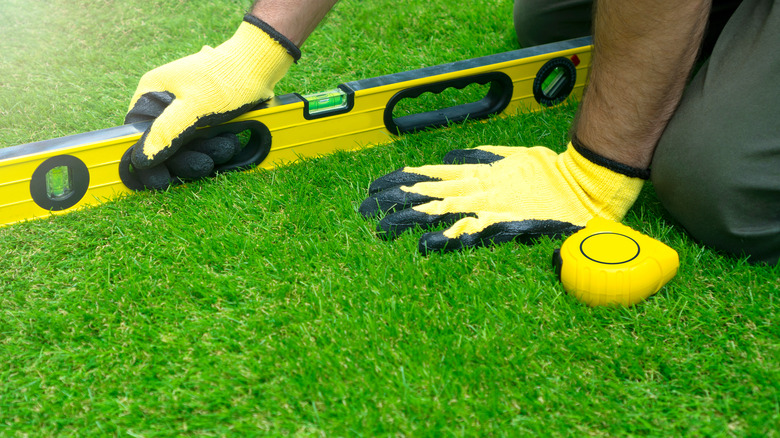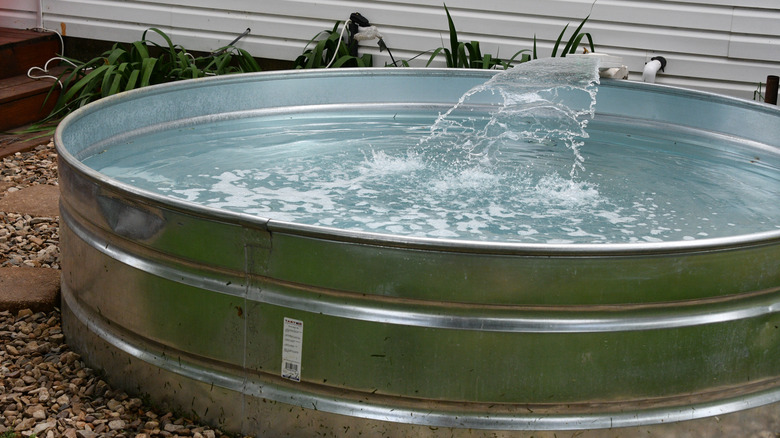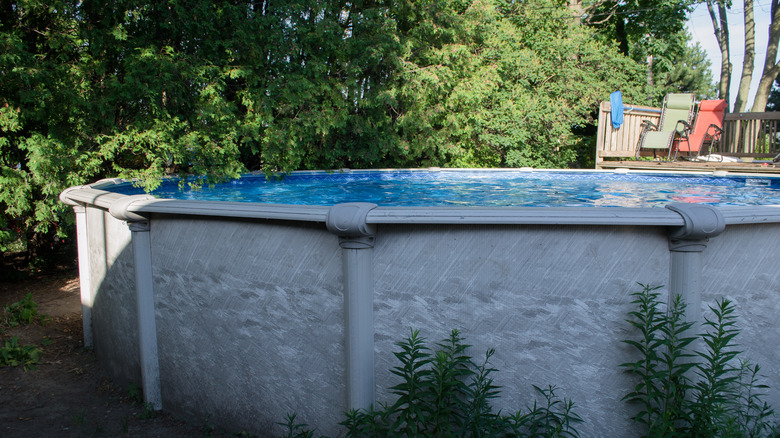Stock Tank Pool: What To Know Before You Buy
If you have spent any time on social media since the first summer of the COVID-19 pandemic, it may seem like everyone and their mother has been installing a stock tank pool in their backyard. These pools, easily recognizable because of their smaller size, round shape, and trademark galvanized steel shine, are so named because they are made out of water tanks whose original use was to water farm livestock such as horses, cattle, goats, and sheep.
The Spruce reports that stock tank pools are often referred to as cowboy pools, hillbilly pools, plunge pools, and trough pools. Because buying and installing a stock tank pool in your backyard is a much more simple and inexpensive process than the one for a traditional inground pool, stock tank pools are only rising in popularity. Their versatility, ability to be customized and adapted, and ease of maintenance are great reasons you should hop on the stock tank pool train.
The stock tank pool trend
According to The New York Times' Wirecutter, stock tank pools first gained popularity in the summer of 2020. During the initial peak of the COVID-19 pandemic, many people were reluctant to visit public pools and beaches, but they did not want to give up the opportunity to cool off during a hot summer day. Stock tank pools, which are dramatically less expensive to install and maintain than traditional inground pools, have become a popular alternative to public swim areas.
It wasn't long before stock tank pools became a hot new yard accessory to boast about on social media, and it's easy to see why: they are incredibly striking and can be adapted to fit any backyard layout and design. The Spruce reports that while you may initially think of stock tank pools as matching a farmhouse or industrial aesthetic, they can easily fit into an urban, desert, boho, country, hippie, or DIY theme. Stock tank pools are stylish without being flashy or in-your-face, and because they are simple to customize, adding one to your yard can be a straightforward way of making the space look more intentional, functional, and fun. If you have been dreaming of creating your own backyard oasis as a sanctuary from COVID-19 or even just the stresses of regular everyday life, installing a stock tank pool is a great way to do it.
Stock tank pools are inexpensive and accessible
Compared to the process of installing an inground pool, getting a stock tank pool up and running is a breeze. Stock tank pools are also a fantastic way of adding a water feature to your yard without breaking the bank. The Bathtubber reports that, while the cost of putting in a traditional inground pool can set you back $20,000 or more, you can install the stock tank alternative for $250 to $1,000 in total. You will not need to take out a loan or set up financing to find some measure of coolness in the summer if you go with the stock tank pool option.
Stock tank pools are also reasonably easy to install and maintain. You likely will not need to bring in a professional contractor or hire an ongoing pool maintenance service, both of which can become quite expensive. According to The Spruce, you may even be able to get away with installing a pool without a pump system. Forgoing a pump will require you to be more active in your pool maintenance, either through regularly draining and refilling the tank or adding chlorine tablets and adjusting other chemicals to the water, while being meticulous with fishing out debris with your pool net.
Stock tank pools come in a variety of sizes
We are not yet at the point where stock tanks are so popular that companies are designing them to be specifically used as swimming pools. When choosing a stock tank as a pool, you have to select from the different sizes associated with providing water to other kinds of livestock. The stock tank standard model is 2 feet high and about 8 feet in diameter. You can find smaller models around 6 feet in diameter, and the largest models go all the way up to 10 feet, per the Family Handyman.
Because stock tank pools are on the smaller side, they may not be ideal if you are looking for a long-term water entertainment option for a large family with a bunch of kids. But if your kids are still relatively young and small, or if you are looking for a way for a few adults to be able to relax and chill out during hot summer days, stock tank pools are a fantastic choice. They are also an excellent option for installing on a deck or a patio — just make sure your deck is strong enough to support the weight! Or for smaller yards that would never be able to accommodate the size of a traditional inground pool.
Types of stock tank pools
Stock tank pools come in only two options, distinguished by the materials they are composed of. Traditional stock tank pools, the ones you see featured all over Instagram and Pinterest, are made of galvanized steel, according to The Bathtubber. These pools have the advantage of being hardier and will likely last much longer. They are also more aesthetically pleasing and are easy to customize, and they provide your yard with that classic stock tank pool look.
The thing to consider with galvanized steel pools is that they tend to be more expensive. If you want to save some money on your stock tank pool installation, you could go with the polyethylene variety, sometimes referred to as a poly pool. Polyethylene is a type of plastic, meaning that your stock tank pool will not be as striking as the galvanized steel version. But you could always paint the outside of your poly pool to match your yard's aesthetic. Another benefit of poly pools is that they are softer and more forgiving than galvanized steel. So, if you are worried about small children getting a little rambunctious while swimming and crashing into the side of the tank, a poly stock tank pool may be the way to go.
Prepping your yard for a stock tank pool
The New York Times' Wirecutter provides a comprehensive guide to buying and installing your new stock tank pool. Before you purchase a stock tank, you will need to make sure there is space in your yard to install it safely. If you place a stock tank pool in an area not entirely leveled, the water will tilt slightly towards one side of the tank. This positioning will apply more pressure onto the area and make it wear down quickly — not to mention, water is more likely to spill out of that side of the tank and further erode the soil underneath. If you do not have a completely leveled area in your yard that is big enough for your pool, you will probably have to level out the ground yourself, digging it down and installing gravel to balance out the dips.
If you plan on using a pool pump, you also need to make sure that the ground you are leveling out is close to a power source to plug your pump into. If you do not have an outlet nearby, you will probably have to insulate your pool pump's wiring and then bury it into the ground, which can get tricky.
Installing a stock tank pool
Stock tanks can be purchased at feed stores and tractor supply stores, most of which, unlike home improvement stores, will not deliver to your house, according to The New York Times' Wirecutter. So, the first thing you may need to do when buying a stock tank is rent a truck if you do not already own one. Once you have your stock tank home and set up on your pre-leveled ground, check it for leaks by running a hose around the interior sides. You can fix leaks using epoxy or reach out to the tank's manufacturer, and they will usually send you some leak sealant, often for free!
If installing a pump, you will need to drill two holes in the side of your stock tank, one for a hose to suck dirty water out from the bottom of the pool into the pump's filtration system and one to send clean water back to the top of the pool once it has been sterilized. Finally, it would be best to get your stock tank pool a chlorine floater, AKA a small flotation device that slowly and steadily dispenses chlorine into the water after being stocked with chlorine tablets. You can buy a basic generic floater or find floaters with cute designs such as flamingos or emojis.
Benefits of a stock tank pool
If you choose to go the stock tank pool route, there are several benefits that you could never encounter with a traditional in-ground pool, as reported by The Spruce. First, stock tanks themselves are versatile. If you ever decide that you no longer need a small pool in your backyard, and what would really make you happy is a backyard vegetable garden, your stock tank can easily be converted from a pool to a raised gardening bed.
Stock tank pools are also easily moved around. During the winter, if you have not installed a water heating system to turn your stock tank pool into a hot tub, you can get it out of your yard and free up some space by simply draining it and rolling it into your shed or garage. And if you move houses entirely, you can bring your stock tank pool along and reinstall it into your brand-new backyard. Although you may want to leave it right where it is — with how popular stock tank pools are becoming and the viral stock tank pool photos on social media, a house with one of these beauties in its yard could probably have a significantly higher resale value.
